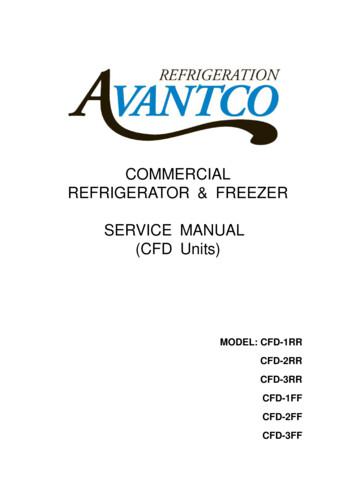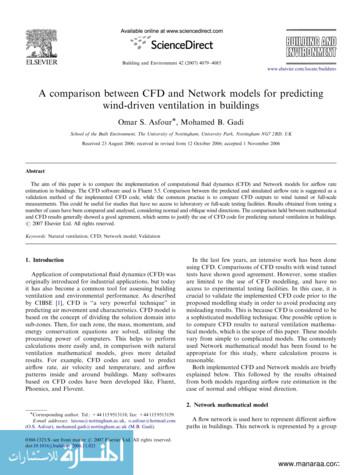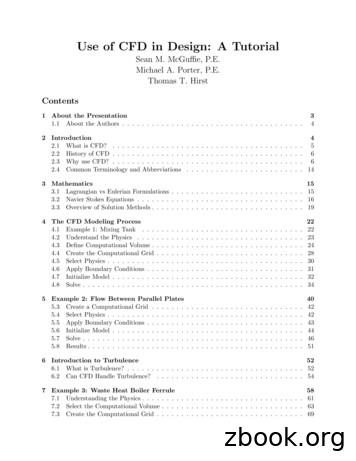CFD Study Of Full-Scale Aerobic Bioreactors - NREL
CFD Study of Full-Scale Aerobic BioreactorsEvaluation of Dynamic O2 Distribution, Gas-LiquidMass Transfer and ReactionDavid Humbird, Hariswaran Sitaraman,Jonathan Stickel, Michael A. Sprague,Jim McMillan2016 AIChE Annual MeetingNovember 18, 2016San Francisco, CaliforniaNREL/PR-5100-66420NREL is a national laboratory of the U.S. Department of Energy, Office of Energy Efficiency and Renewable Energy, operated by the Alliance for Sustainable Energy, LLC.
Computational Science at NRELHPC projects at NREL include: Molecular dynamics of cellulosicenzymes Inverse design for energy materials Wind energy simulationsMechanistic modeling of biochemicalconversion of biomass: Pretreatment, enzymatic hydrolysis,aerobic bioreaction Continuum-scale predictive modeling Based on relevant physical and chemicalprinciples, while remainingcomputational efficient Support process design, parameteroptimization, and estimation of operatingcosts Team of chemical engineers andcomputational scientistsPhoto by Dennis Schroeder, NREL 27494Peregrine is NREL’s flagship HPCcapability: 1.19 PetaFLOPS 31,104 Intel Xeon processors 576 Intel Phi many-core coprocessors 3 petabytes of mass storage2
Industrial aerobic bioprocess NREL research is increasingly focused onadvanced biofuels produced via aerobic microbialproduction pathways (e.g., oleaginous yeast) . At “fuel-scale,” aerobic fermentation is the largestOPEX CAPEX contributor in the process, even inextremely large bioreactors up to 1,000 m3. In order to improve economics throughbioreactor and overall process design, we seekvalidation and improvement of the reactor designequations used in techno-economic analysis.3
CFD of aerobic bioreactors We use CFD to confirm scale-up principlesand optimize full-scale design Existing bioreactor CFD literature focuseson precise hydrodynamics of bubblyflows—no modeling of oxygen distribution We explicitly model O2 mass transfer andconsumption to study dissolved O2concentration distribution in bubblecolumn and airlift bioreactorsoBubble-columns are expected to have lowerCAPEX and OPEX than stirred-tankbioreactors.4
CFD ImplementationNumerical Approach Euler-Euler multiphase simulation in OpenFOAMoreactingTwoPhaseEulerFoam (OpenFOAM-3.0) Reynolds-averaged Navier-Stokes (RANS) k-ε turbulence modelMultiphase assumptions Bubble diameter reactor diameter Single bubble diameter (5 mm)Gas-liquid mass transfer Oxygen transfer rate: OTR 𝑘𝑘L 𝑎𝑎 𝐶𝐶O 2 𝐶𝐶O2 Mass transfer coefficient (Higbie): 𝑘𝑘L Specific interfacial area: 𝑎𝑎 6 𝛼𝛼G𝑑𝑑b 1 𝛼𝛼G4𝐷𝐷 𝑢𝑢slip𝜋𝜋 𝑑𝑑b5
CFD model validation (small scale) Simulate lab-scale bubble columnooooo0.15 m diameter x 1.2 m heightInitial liquid height 0.75 m1,350 cells (45 x 30)Air/water at 20 CZero initial dissolved O2concentration Gas holdup and dissolved oxygenconcentration analyzed6
CFD model validation (small scale) Gas holdup is bound bytheoretical calculation1 anddesign equation of Heijnen andvan’t Riet20.7𝛼𝛼G 0.6𝑣𝑣Gs Rise in O2 concentration tosaturation over time is fit toexponential𝐶𝐶O2 𝐶𝐶O 2 1 exp 𝑘𝑘L 𝑎𝑎𝑎𝑎 Mass transfer coeff comparesfavorably to design equation ofHeijnen and van’t Riet20.7𝑘𝑘L 𝑎𝑎 0.32𝑣𝑣Gs1.2.Iordache and Muntean, 1981Heijnen and van’t Riet, 19847
Oxygen uptake model Oxygen uptake rate (OUR, mmol/L-h) modeledwith phenomenological O2 sink function O2 is removed from liquid phase at this rate Mimics real culture behaviorAnaerobic micro-aerobic fully aerobic8
Gas-on/gas-off simulation Gas-on/gas-off experiment is performed inbench-scale bioreactors to determine operatingparameters (OUR, cell growth rate, kLa)1. t 0 s: Air introducedwith vGs 0.10 m/s2. t 60 s: Air turned off3. t 70 s: O2 sinkfunction activated4. t 85 s: Airreintroduced withvGs 0.10 m/s, sinkfunction still active9
Simulation of commercial-scale reactor Fully-coupled simulationsoooTwo-phase flowInterphase O2 mass transferO2 uptake modelBubble columnDraft-tube airlift Probe for oxygen-depletedareas in full-size reactors Bubble column:ooo5m diameter x 40m height25m initial liquid height25,000 cells (125x200) Draft-tube airliftooo3.5m draft tube in 5m column x40m height25m initial liquid height38,000 cells (190x200)10
Oxygen-limited regions Oxygen-limited defined as𝐶𝐶O2 𝐶𝐶Omaxfrom sink2function (0.05 mol/m3) Operating vGs constant (0.1m/s), OUR increased OTRmax taken as OUR whereO2-limited volume 20%Bubble columnDraft-tube airlift15% oxygen-limited volume in each11
Maximum OTR simulation OTRmax significantly largerin commercial-scalereactoroMore oxygen transferrednear reactor inlet wherepressure is high Observed OTRmax is in linewith bubble columndesign heuristics 100 mol/m3-h at 0.14 m/s Additional data currentlyin production12
Economic considerations Previously demonstrated thatCFD validates the reactor designequations used in technoeconomic analysis OTRmax f(vGs) data fromcommercial-scale simulationsgives O2 delivery cost equivalentto design equations Additional OTRmax f(vGs) resultswill supplement or replace thedesign equations CFD simulations will informminimum superficial velocity andmaximum reactor sizeAggregate (CAPEX OPEX) O2delivery cost in bubble columnas a function of OUR andreactor size13
Summary Two-phase flow in bubble-column bioreactors wassuccessfully simulated, including interphase O2 masstransfer and consumption Gas holdup and O2 mass transfer rates are consistent withtypical bubble column design equations Oxygen-depleted regions occur at elevated oxygen uptakerates (OUR) By simulating multiple OUR levels, maximum oxygentransfer (OTR) rates were obtained for different superficialvelocities of input air OTRmax relationships can inform techno-economic analysisby indicating minimum superficial velocity and maximumreactor size Goal: validate CFD for standard reactors, then applysimulation techniques to novel geometries and operatingspaces14
AcknowledgementsCo-AuthorsNREL National Bioenergy CenterJonathan J. StickelJames D. McMillanNREL Computational Science CenterHariswaran SitaramanMichael A. SpragueFundingUS DOE Contract# DE-AC36-08-GO2308EERE Bioenergy Technology Office (BETO) http://www.eere.energy.gov/biomassNREL’s High Performance Computing resources were used to perform the CFDsimulations http://hpc.nrel.gov/OpenFOAM Project http://openfoam.orgSpeaker information:Dave Humbird, DWH Process Consulting LLCdave@dwhpc.com15
CFD of aerobic bioreactors We use CFD to confirm scale-up principles and optimize full-scale design Existing bioreactor CFD literature focuses on precise hydrodynamics of bubbly flows—no modeling of oxygen distribution We explicitly model O 2 mass transfer and consumption to study dissolved O 2 concentration distribution in bubble -
refrigerator & freezer . service manual (cfd units) model: cfd-1rr . cfd-2rr . cfd-3rr . cfd-1ff . cfd-2ff . cfd-3ff . 1 table of contents
430 allocation to elianto cfd o&m 20,577.32 440 allocation to trillium west cfd o&m 27,267.00 450 allocation to west park cfd o&m 70,008.22 460 allocation to festival ranch cfd o&m 177,790.54 480 allocation to tartesso west cfd o&m 27,809.17 481 allocation to anthem sun valley cfd o&
The CFD software used i s Fluent 5.5. Comparison between the predicted and simulated airflow rate is suggested as a validation method of the implemented CFD code, while the common practice is to compare CFD outputs to wind tunnel or full-scale . Both implemented CFD and Network models are briefly explained below. This followed by the .
A.2 Initial Interactive CFD Analysis Figure 2: Initial CFD. Our forward trained network provides a spatial CFD analysis prediction within a few seconds and is visualised in our CAD software. A.3 Thresholded and Modified CFD Analysis Figure 3: Threshold. The CFD is thresholded to localise on
performing CFD for the past 16 years and is familiar with most commercial CFD packages. Sean is the lead author for the tutorial and is responsible for the following sections: General Procedures for CFD Analyses Modeling Turbulence Example 3 - CFD Analysis
CFD Analysis Process 1. Formulate the Flow Problem 2. Model the Geometry 3. Model the Flow (Computational) Domain 4. Generate the Grid 5. Specify the Boundary Conditions 6. Specify the Initial Conditions 7. Set up the CFD Simulation 8. Conduct the CFD Simulation 9. Examine and Process the CFD Results 10. F
Emphasis is on comparing CFD results, not comparison to experiment CFD Solvers: BCFD, CFD , GGNS Grids: JAXA (D), ANSA (E), VGRID (C) Turbulence Models: Spalart-Allmaras (SA), SA-QCR, SA-RC-QCR Principal results: Different CFD codes on same/similar meshes with same turbulence model generate similar results
Basic Description Logics Franz Baader Werner Nutt Abstract This chapter provides an introduction to Description Logics as a formal language for representing knowledge and reasoning about it. It first gives a short overview of the ideas underlying Description Logics. Then it introduces syntax and semantics, covering the basic constructors that are used in systems or have been introduced in the .























